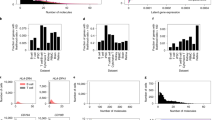Abstract
Single-cell data provide a means to dissect the composition of complex tissues and specialized cellular environments. However, the analysis of such measurements is complicated by high levels of technical noise and intrinsic biological variability. We describe a probabilistic model of expression-magnitude distortions typical of single-cell RNA-sequencing measurements, which enables detection of differential expression signatures and identification of subpopulations of cells in a way that is more tolerant of noise.


Similar content being viewed by others
References
Tang, F. et al. Nat. Methods 6, 377–382 (2009).
Islam, S. et al. Genome Res. 21, 1160–1167 (2011).
Hashimshony, T., Wagner, F., Sher, N. & Yanai, I. Cell Reports 2, 666–673 (2012).
Ramsköld, D. et al. Nat. Biotechnol. 30, 777–782 (2012).
Dalerba, P. et al. Nat. Biotechnol. 29, 1120–1127 (2011).
Tang, F. et al. PLoS ONE 6, e21208 (2011).
Brouilette, S. et al. Dev. Dyn. 241, 1584–1590 (2012).
Buganim, Y. et al. Cell 150, 1209–1222 (2012).
Munsky, B., Neuert, G. & van Oudenaarden, A. Science 336, 183–187 (2012).
Brennecke, P. et al. Nat. Methods 10, 1093–1095 (2013).
Wills, Q.F. et al. Nat. Biotechnol. 31, 748–752 (2013).
Deng, Q., Ramskold, D., Reinius, B. & Sandberg, R. Science 343, 193–196 (2014).
Anders, S. & Huber, W. Genome Biol. 11, R106 (2010).
Trapnell, C. et al. Nat. Biotechnol. 31, 46–53 (2013).
McDavid, A. et al. Bioinformatics 29, 461–467 (2013).
Robinson, M.D. & Smyth, G.K. Bioinformatics 23, 2881–2887 (2007).
Moliner, A., Enfors, P., Ibanez, C.F. & Andang, M. Stem Cells Dev. 17, 233–243 (2008).
Tischler, J. & Surani, M.A. Curr. Opin. Biotechnol. 24, 69–78 (2013).
Cauffman, G. et al. Mol. Hum. Reprod. 11, 405–411 (2005).
Pan, H.A. et al. Fertil. Steril. 89, 1324–1327 (2008).
Trapnell, C., Pachter, L. & Salzberg, S.L. Bioinformatics 25, 1105–1111 (2009).
Grün, B., Scharl, T. & Leisch, F. Bioinformatics 28, 222–228 (2012).
Andäng, M., Moliner, A., Doege, C.A., Ibanez, C.F. & Ernfors, P. Nat. Protoc. 3, 1013–1017 (2008).
Acknowledgements
We thank X. Wang (Harvard Medical School) for help with packaging the implementation and F. Ferrari (Harvard Medical School) and M.B. Johnson (Children's Hospital, Boston) for critical review of the manuscript and SCDE implementation. This work was supported by US National Institutes of Health (NIH) grant K25AG037596 to P.V.K., fellowship awards from Leukemia and Lymphoma Research UK and Leukemia and Lymphoma Society to L.S. and NIH grants R01DK050234-15A1 and R01HL097794-03 to D.T.S.
Author information
Authors and Affiliations
Contributions
P.V.K. conceived and implemented the computational approach. L.S. and D.T.S. designed and carried out the initial experimental study that led to the development of the presented approach.
Corresponding author
Ethics declarations
Competing interests
D.T.S. is a shareholder in Fate Therapeutics and is a consultant for Fate Therapeutics, Hospira, GlaxoSmithKline and Bone Therapeutics. The remaining authors declare no competing financial interests.
Supplementary information
Supplementary Text and Figures
Supplementary Figures 1–5 (PDF 1451 kb)
Supplementary Software
Software for single-cell differential analysis. (ZIP 499 kb)
Rights and permissions
About this article
Cite this article
Kharchenko, P., Silberstein, L. & Scadden, D. Bayesian approach to single-cell differential expression analysis. Nat Methods 11, 740–742 (2014). https://doi.org/10.1038/nmeth.2967
Received:
Accepted:
Published:
Issue Date:
DOI: https://doi.org/10.1038/nmeth.2967
- Springer Nature America, Inc.
This article is cited by
-
iDESC: identifying differential expression in single-cell RNA sequencing data with multiple subjects
BMC Bioinformatics (2023)
-
Single-cell RNA-sequencing of stria vascularis cells in the adult Slc26a4-/- mouse
BMC Medical Genomics (2023)
-
Inflammation across tissues: can shared cell biology help design smarter trials?
Nature Reviews Rheumatology (2023)
-
Heterochronic parabiosis reprograms the mouse brain transcriptome by shifting aging signatures in multiple cell types
Nature Aging (2023)
-
Reversing pancreatic β-cell dedifferentiation in the treatment of type 2 diabetes
Experimental & Molecular Medicine (2023)





